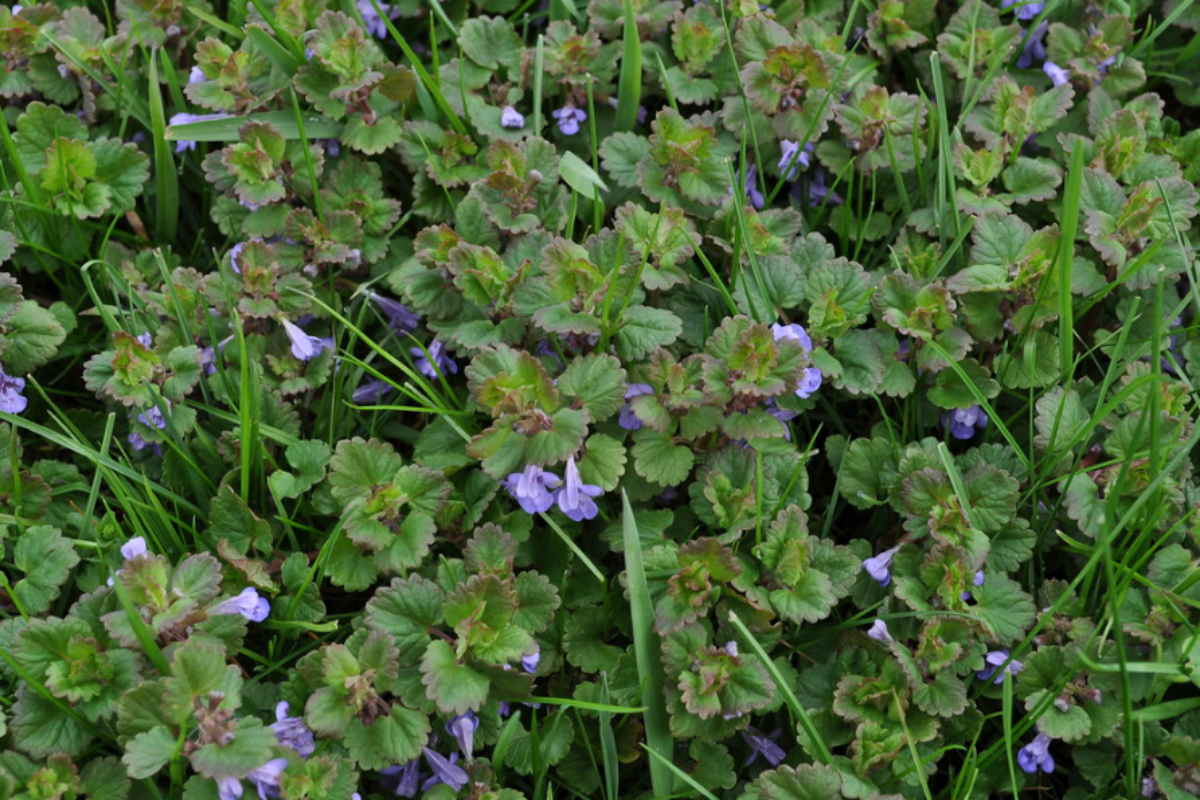Glechoma hederacea is an evergreen perennial herb that is most notable for its creeping habit, spreading on the ground up to 30 feet to form low-growing mats.

You can identify it by its square stems, shiny, dark-green, kidney-shaped leaves with scalloped edges, and upright spikes bearing clusters of purple-blue flowers.
Creeping Charlie Classification
- Domain: Eukaryota
- Kingdom: Plantae
- Phylum: Spermatophyta
- Subphylum: Angiospermae
- Class: Dicotyledonae
- Order: Lamiales
- Family: Lamiaceae
- Genus: Glechoma
- Species: Glechoma hederacea
- Varieties: Glechoma hederacea var. Micrantha and Glechoma hederacea var. parviflora
- Common Names: Field Balm, Runaway Robin, Cat’s Foot, Haymaids, and Alehoff
Nativity and Distribution
Ground Ivy is native to Europe and Asia. It has since been introduced and naturalized in many parts of the world, including North America, parts of South America, Australia, and New Zealand.
Physical Characteristics

- Leaves: Kidney-shaped to ovate cordate leaves with scalloped edges
- Fruits: Ovoid, flat, 2-sided nutlet
- Stems: Prostrate to slightly ascending square stems
- Flowers: Tubular blue-purple flowers
- Roots: Fibrous root system
G. hederacea is a perennial herb that has a creeping habit (hence the name Creeping Charlie), forming carpet-like mats.
It is easily identifiable by its 4-sided stems, shiny, dark-green, kidney-shaped leaves with scalloped edges, and upright spikes bearing clusters of purple-blue flowers.
Ground Ivy leaves are kidney-shaped to ovate cordate and heart-shaped at the base, with scalloped edges. The opposed leaves are smooth or stiff-haired, about 0.4-1.2 inches long, with petioles attaching the base of the leaf to the stem. Where the conditions are favorable, the leaves remain evergreen.
Stems are square and grow upwards about 4-16 inches tall. After flowering, the stems arch down and spread up to 30 feet horizontally. The vertical stems are thicker than the stolons and covered in stiff hairs or entirely smooth.
The flowers of Creeping Charlie are tubular, blue-violet, 0.5-0.9 inches long, and occur in clusters of three to seven on the leaf axils. Flowering occurs in early to mid spring.
The seeds are ovoid, flattened, dark brown, about 0.12 inches in size.
Reproduction, Dispersal, and Life Cycle
- Life Cycle: Perennial
- Seeds: Seed production varies with location
- Climate: Temperate climate
- Dispersal: Animals and humans
Ground Ivy behaves as a perennial and reproduces by seed and vegetatively by creeping stolons. Seed production varies with regions, with some plants producing large quantities of seeds, rarely, or none at all.
While the seeds are typically viable, they are not particularly adapted to assist in their dispersal, and hence the unintentional movement of stolon fragments accounts for larger infestations in new areas.
The weed emerges in spring, flowers, and sets seeds throughout summer. After flowering, the slightly ascending stems bend to the ground and continue reproduction through rooting stolons.
The long, slender stolons form fibrous roots at the nodes, creating new stems and more stolon fragments. This clonal formation creates carpet-like mats that can cover large areas.
In the colder autumn and winter months, the weed forms ramets that break away from the parent stolon to form overwintering fragments.
While it prefers moist, fertile soils and shady areas, it can adapt to diverse conditions and environments.
Creeping Charlie is mostly found in riparian areas, prairies, wetlands, thickets, forest edges, roadsides, gardens, and lawns.
Similar Plants
- Lamium amplexicaule
- Lamium purpureum
- Malva neglecta
Uses

- Ground Ivy is a popular ornamental plant for hanging baskets and as a groundcover.
- It was an important medicinal herb used to treat coughs, bronchitis, tinnitus, cataracts, and many other conditions.
- The plant is a forage crop for mammals and insects and provides nesting material for birds like starlings.
- Pre-bloom leaves are used to make tea, green salad, or cooked as a vegetable.
Impact on Farms and Environment
G. hederacea can invade gardens where smaller crops are growing, competing for nutrients, water, and sunlight. Its dense growth and creeping stems can also crowd out the desirable plants, leading to reduced crop yields and increased costs for weed management.
As a common weed in lawns, it can reduce the health and aesthetic appeal of the turf, especially since it’s hard to control without harming the grass.
In natural ecosystems, it has the potential to displace native vegetation by forming thick mats that shade out or kill them. A rapid invasion can reduce biodiversity and disrupt the balance of native plant communities.
Creeping Charlie is also reported to be toxic to livestock, especially horses, if ingested fresh or in hay.
Control
- Mechanical control: Pulling or raking
- Chemical control: Apply herbicides like isoxaben and herbicide mixtures like 2,4-D, MCCP, and dicamba.
G. hederacea is difficult to control by mechanical strategies due to its rooting stolons. Methods like hand-pulling or raking can only prove effective if all the stolon fragments are removed.
Chemical herbicides indicated for Ground Ivy removal include pre-emergence products, such as isoxaben. The best postemergence herbicide combinations for lawns and other areas include triclopyr and fluroxypyr, dicamba, 2,4-D, and MCPP.
A mixture containing triclopyr, 2,4-D amine, 2,4-D ester, and fluroxypyr, or quinclorac, dicamba, 2,4-D, and sulfentrazone, applied in the fall, can achieve good control against the weed.

Lead Editor for Insight Weeds.